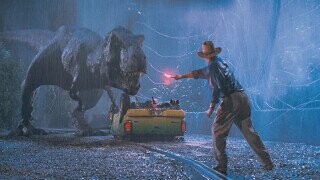'Jurassic Park' Taught Us All The Wrong Things About T-Rexes

Although it remains Spielberg's best movie featuring a pile of poop the size of Jabba the Hutt, we regret to inform you that Jurassic Park is simply not very good as a PSA on how to deal with a Tyrannosaurus Rex. Sure, a lot of the inaccuracies are there because we knew less about T-Rexes in 1993 than we do in 2022, but that doesn't make the myths in this movie any less dangerous. So, should you ever find yourself in the late-Jurassic-to-late-Cretaceous Periods, please, for your own safety, forget what Misleadin' Steven told you and keep the following advice in mind:
They COULD See You If You Weren't Moving, Duh
Don't pretend you didn't file the words "He can't see us if we don't move" in an important your brain the second you saw this scene in Jurassic Park, just in case they were ever useful in the future:
As the movie's foremost dinosaur expert says a minute earlier, the T-Rex's vision is "based on movement," so you become invisible to them if you "keep absolutely still." It's a nice little factoid that's also completely untrue. T-Rexes had "really good vision" and a fantastic field of view -- better than a modern-day eagle, an animal known for its awesome eyes. Their hearing and smell were also pretty great (based on advanced CT scans of their skulls), so even if they somehow missed you standing still in front of them, they'd probably smell you peeing yourself and eat you anyway.
Some believe that this particular T-Rex's vision works differently because she has frog DNA, but this is stated nowhere in the movie (OR the book, despite what the internet claims). How many time-travelers have died, or will one day have died because of this scene? That blood is in your hands, Spielberg.
They Couldn't Run Without Breaking Their Legs
Another reason why the "don't move" myth is so wildly irresponsible is that it might prevent you from immediately hauling ass the second you see a T-Rex, which would be dumb since they were way slower than in the movies. At the time Jurassic Park came out, it was believed the T-Rex could gallop at about 45 miles per hour, but new studies concluded that they were limited to a walking speed of about 12 miles per hour. That's still faster than the average couch potato, but it means that the dramatic jeep chase sequence from the movie would have been a lot less exciting in reality.
The T-Rex's relatively leisurely pace wasn't due to them being lazy, but because (based on AI model simulations) they literally couldn't run without breaking their leg bones due to their weight. This means that Jurassic Park tragically neglected to mention the single most effective way to deal with a T-Rex: trick them into a race and then make fun of them when they're crippled on the ground.
Their Jaws Were More Silent AND Deadly Than You Think
There are two major mistakes in the classic scene where the T-Rex eats a lawyer on the toilet. First, experts now believe these dinosaurs didn't roar: if they made a noise, it probably sounded more like a quack. If Steven Spielberg has any decency, he will immediately recall all copies of this movie and reissue them with Donald Duck sounds in the scene below instead of that fictitious roar.
The second blunder is that a T-Rex probably wouldn't shake the lawyer's corpse like a dog, since their bite was a lot more powerful than the movie shows -- they could even bite through bones or any of those jeeps they had in the park. Picture this: you're sitting in a prehistoric jungle and you hear a quacking sound. You think, "That sounded nothing like a roar so it couldn't possibly be a--" Next thing you know, you're cut in half and cursing Spielberg's name in your final seconds.
They Liked Dancing And They Looked DIVINE
Another important thing Spielberg failed to warn us about is how disarmingly fabulous a real T-Rex would look: one paleontologist describes them as "a bus-sized Big Bird from hell." The discovery of melanin on fossils seems to confirm the theory that they had colorful feathers on "attention-getting" parts of their body ... because they would "wave and wiggle and flaunt" them around to attract mates. Yes, T-Rexes liked to dance to make each other horny. Based on that information, here's a far more accurate simulation than what we see in Jurassic Park:
Shame on you for denying us that, Spielberg.
Follow Maxwell Yezpitelok's heroic effort to read and comment on every '90s Superman comic at Superman86to99.tumblr.com.
Top image: Universal Pictures